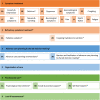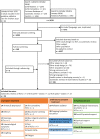Palliative care for children: methodology for the development of a national clinical practice guideline
- PMID: 38041060
- PMCID: PMC10691037
- DOI: 10.1186/s12904-023-01293-3
Palliative care for children: methodology for the development of a national clinical practice guideline
Abstract
Background: Provision of paediatric palliative care for children with life-threatening or life-limiting conditions and their families is often complex. Guidelines can support professionals to deliver high quality care. Stakeholders expressed the need to update the first Dutch paediatric palliative care guideline with new scientific literature and new topics. This paper provides an overview of the methodology that is used for the revision of the Dutch paediatric palliative care guideline and a brief presentation of the identified evidence.
Methods: The revised paediatric palliative care guideline was developed with a multidisciplinary guideline panel of 72 experts in paediatric palliative care and nine (bereaved) parents of children with life-threatening or life-limiting conditions. The guideline covered multiple topics related to (refractory) symptom treatment, advance care planning and shared-decision making, organisation of care, psychosocial care, and loss and bereavement. We established six main working groups that formulated 38 clinical questions for which we identified evidence by updating two existing systematic literature searches. The GRADE (CERQual) methodology was used for appraisal of evidence. Furthermore, we searched for additional literature such as existing guidelines and textbooks to deal with lack of evidence.
Results: The two systematic literature searches yielded a total of 29 RCTs or systematic reviews of RCTs on paediatric palliative care interventions and 22 qualitative studies on barriers and facilitators of advance care planning and shared decision-making. We identified evidence for 14 out of 38 clinical questions. Furthermore, we were able to select additional literature (29 guidelines, two textbooks, and 10 systematic reviews) to deal with lack of evidence.
Conclusions: The revised Dutch paediatric palliative care guideline addresses many topics. However, there is limited evidence to base recommendations upon. Our methodology will combine the existing evidence in scientific literature, additional literature, expert knowledge, and perspectives of patients and their families to provide recommendations.
Keywords: Clinical practice guideline; Evidence-based medicine; Paediatric palliative care.
© 2023. The Author(s).
Conflict of interest statement
The authors declare no competing interests.
Figures




References
-
- Kenniscentrum kinderpalliatieve zorg. Wist U dat?. 2019. Available from: https://kinderpalliatief.nl/over-kinderpalliatieve-zorg/wat-is-kinderpal.... Updated 2019, March 26; Cited 2021 July 21.
-
- Centraal Bureau voor Statistiek. Overledenen; Doodsoorzaak (uitgebreide lijst), leeftijd, Geslacht. Statline; 2022. Available from: https://opendata.cbs.nl/statline/#/CBS/nl/dataset/7052_95/table?ts=16629.... Updated 2022, Dec 20; Cited 2023 Feb 22.
-
- World Health Organization. Integrating palliative care and symptom relief into paediatrics: a WHO guide for health-care planners, implementers and managers. 2018.
-
- Chambers L. A Guide to Children’s Palliative Care. 4th ed. Bristol: Together for Short Lives; 2018. Available from: (https://www.togetherforshortlives.org.uk/wp-content/uploads/2018/03/TfSL...). Cited 2021 July 21.
Publication types
MeSH terms
LinkOut - more resources
Full Text Sources
Medical

